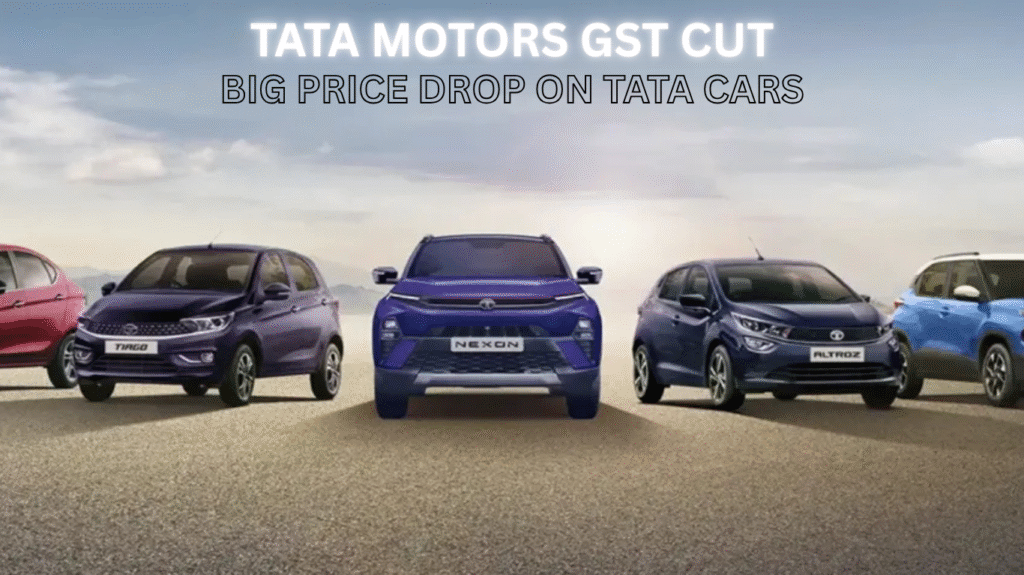
In a landmark move for the Indian automobile sector, Tata Motors price cut has been announced across multiple popular models, directly benefiting from the recent GST revision introduced by the government. This decision not only strengthens Tata Motors’ position in the market but also delivers significant relief to car buyers, especially in the entry-level and mid-segment categories.
The revised GST framework has created opportunities for automakers to transfer tax benefits to customers, and Tata Motors is one of the first major brands to adopt this customer-centric approach. With a Tata Motors price cut spanning models like Tiago, Tigor, Altroz, Punch, Safari, and Harrier, buyers can now own safer, feature-rich vehicles at more affordable rates.
Why Tata Motors Price Cut After GST Revision Is a Big Deal
Taxes form a large chunk of vehicle prices in India. The recent GST revision on passenger vehicles has lowered the effective tax rate for select segments, including hatchbacks, compact SUVs, and sedans. Instead of absorbing the benefit, Tata Motors decided to pass on the relief to customers, ensuring affordability remains a key pillar of its strategy.
This bold move ensures:
- Customers save more upfront on new car purchases.
- Tata Motors stays ahead of competitors who are still evaluating their pricing strategy post-GST revision.
- First-time buyers and families find premium safety and comfort features more accessible.
New Prices of Tata Motors Cars After the Price Cut
Here is the updated pricing of Tata’s major models after the Tata Motors price cut:
| Model | Reduction in Price (Rs.) |
|---|---|
| Tiago | up to 75,000/- |
| Tigor | up to 80,000/- |
| Altroz | up to 1,10,000/- |
| Punch | up to 85,000/- |
| Nexon | up to 1,55,000/- |
| Curvv | up to 65,000/- |
| Harrier | up to 1,40,000/- |
| Safari | up to 1,45,000/- |
The most models indicates Tata Motors’ intent to drive higher volumes across both compact and premium car segments.
Customer Benefits Beyond Just Lower Prices
While the headline is the Tata Motors price cut, the long-term benefits are even more compelling:
- Lower Loan Burden – With reduced on-road pricing, EMIs for Tata cars will be lighter on the pocket.
- Boost in Value-for-Money Quotient – Cars like the Altroz and Punch, already segment leaders in safety, now deliver better affordability too.
- Encouragement to Shift Towards Safer Cars – As Tata Motors cars are known for their 4-star and 5-star safety ratings, more customers may prefer these over cheaper but less safe alternatives.
- Support for GST Policy Adoption – Tata’s proactive step validates the government’s aim of making cars more accessible.
Market Reactions to Tata Motors Price Cut
Social media has been buzzing with reactions. Customers and industry experts have praised Tata for immediately passing the benefits of GST revision to the market.
This kind of positive sentiment not only boosts consumer confidence but also strengthens Tata’s brand reputation as a customer-first automaker.
Impact on Rivals
The Tata Motors price cut will create ripples across the Indian auto industry:
- Maruti Suzuki may face challenges with Baleno and Brezza pricing.
- Hyundai will likely reassess i20 and Venue price tags.
- Mahindra and Kia may also be forced to introduce competitive discounts or new feature packs.
By acting swiftly, Tata Motors has set a new benchmark in price leadership, leaving rivals to play catch-up.
Why GST Revision Aligned With Tata’s Strategy
The GST revision provided Tata with the perfect opportunity to:
- Strengthen customer affordability while boosting brand goodwill.
- Encourage sales volumes at a time when the market is showing signs of slowdown.
- Enhance adoption of compact cars and SUVs, segments where Tata already enjoys strong presence.
This alignment between government policy and Tata Motors price cut demonstrates how public-private collaboration can create win-win outcomes for both industries and consumers.
Long-Term Implications of Tata Motors Price Cut
- Higher Sales Growth – With affordability increased, Tata Motors may see a spike in monthly sales.
- EV Adoption Boost – Price-conscious buyers of ICE cars today could transition to Tata EVs in the future.
- Policy Alignment – Other automakers may also be encouraged to transfer GST benefits to buyers.
- Customer Loyalty – Proactive price cuts will strengthen customer trust in Tata Motors as a brand that prioritizes value.
Final Verdict: Tata Motors Price Cut Sets a Customer-Centric Benchmark
The Tata Motors price cut with benefit of the recent GST revision is a landmark decision that combines government tax reforms with brand affordability strategy. By offering uniform price reductions across its portfolio, Tata Motors has not only made cars like Tiago, Tigor, Altroz, Punch, Safari, and Harrier more attractive but also reinforced its image as India’s most customer-driven automaker.
In 2025, this move could redefine the market landscape, increase adoption of safer cars, and push competitors to revisit their strategies. For Indian buyers, this is truly the best time to drive home a Tata vehicle at a significantly better price.
Also read:
KTM 160: The Next Game-Changer in the Entry-Level Sports Segment?
Triumph Rocket 3: The Ultimate Power Cruiser Redefining Motorcycle Performance
BMW G310: The Perfect Entry-Level Premium Motorcycle for Indian Roads
